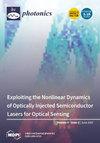带载波储备半导体光放大器的高速 2x1 多路复用器
IF 2.1
4区 物理与天体物理
Q2 OPTICS
引用次数: 0
摘要
本研究利用载流子存储半导体光放大器(CR-SOAs)的快速载流子恢复时间和最小偏振敏感性,将其嵌入到马赫-泽恩德干涉仪(MZI)装置中,以模拟工作频率为 120 Gb/s 的 2x1 多路复用器(MUX)。重点是将 AND 逻辑门功能纳入基于 CR-SOAs 的 MZI 结构,以促进高质量的多路复用。所提出的方法利用基于 CR-SOAs 的 MZI 的固有增益和相位调制功能来有效地处理数据流。这种创新方法利用了 CR-SOAs 的独特性能,如快速响应时间和低极化敏感性,从而实现了最佳信号传输质量和高效多路复用。为了评估多路复用器的性能,引入了质量因子指标作为信号完整性的综合衡量标准。通过详尽的模拟和细致的分析,研究证明了在保持卓越信号传输质量的同时实现所需的数据传输速率的可行性。研究结果强调了基于 CR-SOAs 的 MZI 作为高速多路复用应用的多功能模块的功效,可提供无与伦比的性能和效率。这项研究是对光通信系统认识的重大进步,为在实际应用中优化信号质量和减少干扰提供了宝贵的见解。本文章由计算机程序翻译,如有差异,请以英文原文为准。
High-Speed 2x1 Multiplexer with Carrier-Reservoir Semiconductor Optical Amplifiers
Leveraging the rapid carrier recovery times and minimal polarization sensitivity of carrier-reservoir semiconductor optical amplifiers (CR-SOAs), this study embeds them in a Mach–Zehnder interferometer (MZI) setup to emulate a 2x1 multiplexer (MUX) operating at 120 Gb/s. The focus is on incorporating AND logic gate functionalities into the CR-SOAs-based MZI structure to facilitate high-quality multiplexing. The proposed methodology utilizes the intrinsic gain and phase modulation capabilities of CR-SOAs-based MZI to effectively manipulate data streams. This innovative approach capitalizes on the unique properties of CR-SOAs, such as fast response times and low polarization sensitivity, to achieve optimal signal transmission quality and efficient multiplexing. To assess MUX performance, a quality factor metric is introduced as a comprehensive measure of signal integrity. Through exhaustive simulations and meticulous analysis, the study demonstrates the feasibility of achieving the desired data rate while maintaining superior signal transmission quality. The results underscore the efficacy of CR-SOAs-based MZI as versatile modules for high-speed multiplexing applications, offering unparalleled performance and efficiency. This research represents a significant advancement in understanding optical communication systems and provides valuable insights for optimizing signal quality and mitigating interference in practical real-world scenarios.
求助全文
通过发布文献求助,成功后即可免费获取论文全文。
去求助
来源期刊

Photonics
Physics and Astronomy-Instrumentation
CiteScore
2.60
自引率
20.80%
发文量
817
审稿时长
8 weeks
期刊介绍:
Photonics (ISSN 2304-6732) aims at a fast turn around time for peer-reviewing manuscripts and producing accepted articles. The online-only and open access nature of the journal will allow for a speedy and wide circulation of your research as well as review articles. We aim at establishing Photonics as a leading venue for publishing high impact fundamental research but also applications of optics and photonics. The journal particularly welcomes both theoretical (simulation) and experimental research. Our aim is to encourage scientists to publish their experimental and theoretical results in as much detail as possible. There is no restriction on the length of the papers. The full experimental details must be provided so that the results can be reproduced. Electronic files and software regarding the full details of the calculation and experimental procedure, if unable to be published in a normal way, can be deposited as supplementary material.
 求助内容:
求助内容: 应助结果提醒方式:
应助结果提醒方式:


